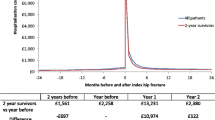Abstract
Summary
To assess the impact of the aging population on the occurrence of fragility fractures, we examined hospital discharges for hip fracture among U.S. women and men aged 45 years and older from 1993 through to 2003. The number of hospitalizations declined by 5%, and age-adjusted rates fell by over 20% for both women and men during this period.
Introduction
Although the aging of the population should mean an increasing burden of fragility fractures, several recently published reports suggest regional declines in the incidence of hip fracture. We investigated trends in hospital discharges and utilization for hip fractures across the USA from 1993 to 2003.
Methods
Hospital discharges from the Nationwide Inpatient Sample from 1993 through to 2003 were analyzed for numbers of primary diagnosis of hip fracture and associated average length of stay (LOS) and charges among women and men aged 45 years and older. Age-specific rates were constructed using national census data.
Results
Over the 11-year study period the number of hospitalizations for hip fractures decreased by 5%, from 296,000 to 281,000. The numbers of discharges declined by 16,600 (7.4%) for women and increased by 1900 (2.6%) among men. However, age-adjusted rates for both women and men fell by about 20%. Average hospital LOS was reduced by about 35% for both sexes, resulting in decreases in days of care of 42 and 33% for women and men, respectively. At the same time, average inflation-adjusted charges for each hospitalization grew by 35% for women and 38% for men, and increasing proportions of patients were discharged to continuing institutional care. During the study interval the total number of prescriptions per year for bisphosphonate anti-resorptive agents grew from under 0.5 to 30 million.
Conclusions
Despite the increasing size of the older segment of the U.S. population, hospitalizations for hip fractures are not increasing. With declining lengths of stay there has been a reduced demand on hospital resources, although with average charges per hospitalization rising and more patients being discharged to other institutions for continuing care the economic consequences of hip fracture continue to increase.
Similar content being viewed by others
References
Fang J, Freeman R, Jeganathan R, Alderman MH (2004) Variations in hip fracture hospitalization rates among different race/ethnicity groups in New York City. Ethnic Dis 14:280–284
Zingmond DS, Melton LJ, 3rd, Silverman SL (2004) Increasing hip fracture incidence in California hispanics, 1983 to 2000. Osteoporos Int 15:603–610
National Center for Health Statistics (1998, 2000, 2002, 2003, 2004). National Center for Health Statistics, Hyattsville, Md.
Agency for Healthcare Research and Quality (AHRQ). Healthcare Cost and Utilization Project (HCUP). HCUP, Rockville, Md. (http://www.ahrq.gov/data/hcup/)
Population Estimates Program, Population Division, U.S. Census Bureau, Washington D.C.
IMS Health. National Prescription Audit Plus, Plymouth Meeting, Pa.
Jaglal SB, Weller I, Mamdani M et al. (2005) Population trends in BMD testing, treatment, and hip and wrist fracture rates: are the hip fracture projections wrong? J Bone Miner Res 20:898–905
Chang KP, Center JR, Nguyen TV, Eisman JA (2004) Incidence of hip and other osteoporotic fractures in elderly men and women: Dubbo Osteoporosis Epidemiology Study. J Bone Miner Res 19:532–536
Black DM, Thompson DE, Bauer DC et al (2000) Fracture risk reduction with alendronate in women with osteoporosis: the Fracture Intervention Trial. FIT Research Group. J Clin Endocrinol Metab 85:4118–4124
McClung MR, Geusens P, Miller PD et al (2001) Effect of risedronate on the risk of hip fracture in elderly women. Hip Intervention Program Study Group. N Engl J Med 344:333–340
Nguyen ND, Eisman JA, Nguyen TV (2006) Anti-hip fracture efficacy of bisphosphonates: a Bayesian analysis of clinical trials. J Bone Miner Res 21:340–349
Stafford RS, Drieling RL, Hersh AL (2004) National trends in osteoporosis visits and osteoporosis treatment, 1988–2003. Arch Intern Med 164:1525–1530
Elliot-Gibson V, Bogoch ER, Jamal SA, Beaton DE (2004) Practice patterns in the diagnosis and treatment of osteoporosis after a fragility fracture: a systematic review. Osteoporos Int 15:767–778
Interest to declare
The authors are supported by funding from the Alliance for Bone Health.
Author information
Authors and Affiliations
Corresponding author
Additional information
This research was supported in part by a grant from the Alliance for Bone Health (Procter & Gamble Pharmaceuticals and Sanofi-Aventis).
Rights and permissions
About this article
Cite this article
Gehlbach, S.H., Avrunin, J.S. & Puleo, E. Trends in hospital care for hip fractures. Osteoporos Int 18, 585–591 (2007). https://doi.org/10.1007/s00198-006-0281-0
Received:
Accepted:
Published:
Issue Date:
DOI: https://doi.org/10.1007/s00198-006-0281-0




